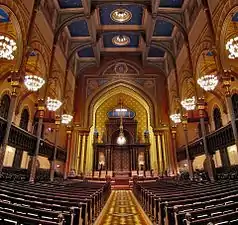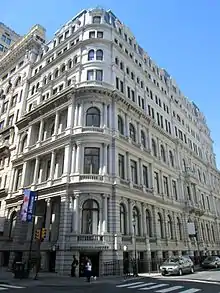Henry Fernbach
Henry Fernbach (1829—1883)[1] was an architect in New York City. Born in Breslau in Germany, he immigrated to the U.S. in 1848[2] or in 1855.[3]

Interior of Central Synagogue

New York Mutual Life Insurance Company Building, top three floors added later designed by Philip Roos
Fernbach was a Prussian Jew,[3] and trained at the Bauakademie in Berlin.[4] He is noted for his synagogue designs, mainly in the Moorish Revival architecture style,[3] and for his cast iron facades. Between 1867 and 1883 Fernbach designed more than two dozen of the properties now contributing to the SoHo - Cast Iron Historic District.[5]
He served as Treasurer of the United Association of American Architect.[2] Alfred Zucker and Theodore de Lemos partnered with him. Paul J. Pelz worked as a chief draftsman for him. He designed the German Savings Bank with Edward H. Kendall.
Work
- First Jewish Orphan Asylum,[2] East 77th Street near Third Avenue,[6] NYC (1863)
- original permanent location, Harmonie Club, 45 West Forty-Second Street, NYC (1867)
- entrance gate, Salem Fields Cemetery, 775 Jamaica Avenue, Brooklyn (1867)[4]
- Temple Emanu-El, 43rd Street and 5th Avenue, with architect Leopold Eidlitz (1868; razed 1927)[7][8]
- Central Synagogue, 652 Lexington Avenue, NYC (1870–72)
- 67, 69, 71, 75, 77, 81 Greene Street (1873)[9]
- Victory Building, 1001-05 Chestnut Street, Philadelphia, Pennsylvania (1873–75)[10]
- Stern Brothers Department Store, 32-36 West 23rd Street, NYC, expanded in stages (1878, 1878, 1880)
- Eden Musée, 55 West 23rd Street, NYC (Fernbach died mid-project; completed by Theodore de Lemos) (1884)
- 113, 115 Spring Streets, lofts with Tuscan columns and cast iron fronts[9]
- SoHo Hotel at 101-111 Greene Street (not the new buildings 101 and 107-11 by Joseph Pell Lombardi)[9]
References
- "Henry Fernbach". Philadelphia Buildings. Retrieved 5 August 2018.
- Passikoff, Alexander G. (September 8, 2011). A Façade of Buildings: A Collection of Architectural Styles, Architects, and Their Buildings That Make Up the Face of New York pp. 82–83
- Henry Fernbach New York Architecture
- Bedoire, Fredric. The Jewish Contribution to Modern Architecture, 1830-1930 pp. 425–426.
- "NRHP Nomination Form, SoHo Cast Iron Historic District". US Dept of Interior. Retrieved 5 August 2018.
- The New Jewish Orphan Asylum October 29, 1863
- Temple Emanu-El
- Temple Emanu-El image NYC-architecture.com
- White, Norval; Willensky, Elliot; Leadon, Fran. AIA Guide to New York City.
- "New York Mutual Life Insurance Company Building, 1001-1005 Chestnut Street, Philadelphia, Philadelphia County, PA". Library of Congress. Retrieved 5 August 2018.
This article is issued from Wikipedia. The text is licensed under Creative Commons - Attribution - Sharealike. Additional terms may apply for the media files.

